From open mics to touring headliners, sketch shows to improv troupes, Bloomington is a hub for live comedy in the Midwest. Why Bloomington, specifically? Because certain stars aligned over the community: accessible opportunities to learn and perform, structured avenues for artist growth, discerning yet welcoming audiences, exposure to outstanding touring talent, and trusted curators. With the Limestone Comedy Festival celebrating its tenth year next month, let’s take a close look at the city’s comedy scene.
Getting into comedy in Bloomington
The first steps into live comedy vary from artist to artist. Several comedians got their feet wet through student-led groups. For example, comedian Maria Bluck’s involvement with improv troupe Midnight Snack Comedy and sketch troupe The University tWits at Indiana University were foundational. “When I was at IU, there were eight different student groups for comedy, which is huge,” Bluck explains. “Whoever founded those groups probably had some sort of training or read books about how to do improv and sketch. They became experts, then passed it down to the younger students, and so forth. I’m so lucky that people at IU who just love those things for the fun of it taught me.”

Maria Bluck at The Comedy Attic | Photo by Tall and Small Photography
Bluck recently moved to Chicago, where she has been accepted into the conservatory program at Second City, a 13-month improv-to-sketch program. “I think I’m the only one that has never paid for a single Chicago improv class,” she says. “A Second City class can cost 500 bucks. I basically learned how to do it for free, all thanks to my IU comedy education.”
For some comedians, starting with student groups gave them confidence to work up to a club. Local comedian Emily Davis developed an interest in stand-up during high school, which was when she first visited The Comedy Attic to see Ron Funches. “Once I got into college, my main paths were The Comedy Attic, where I was too scared to perform at that point, and campus comedy,” Davis recalls. “So I auditioned for some troupes and ended up in Ladies’ Night Comedy, which was brand new at that time. It gave women and non-binary people opportunities to do both stand-up and sketch, and I got to do both. Once I got my feet under me, I started doing open mics at The Comedy Attic and have been doing it ever since.”
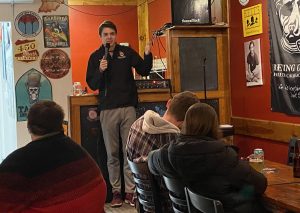
James Tanford at Hoppy Wobbles Pub | Photo by Christine Brackenhoff
Similarly, local comedian James Tanford was involved with improv and sketch comedy groups, but at Oberlin College. “When I graduated and came back to Bloomington, I wandered into an open mic but wasn’t sure I was funny enough to do stand-up. The beauty of open mic, though, is that you see people trying new stuff.” Tanford realized that audiences appreciated efforts to try jokes, regardless of whether the jokes themselves were successful. This gave him assurance to at least give stand-up a try. “As soon as I went up, I was hooked,” Tanford recalls.
Outside of the university, some comedians have learned fundamentals through the Center for Lifelong Learning at Ivy Tech Community College. Local comedian and Limestone Comedy Festival co-founder Mat Alano-Martin reached out to Ivy Tech one year, inquiring about using the Waldron Arts Center as a festival venue, which Ivy Tech managed at the time. Ivy Tech accepted, with the condition that Alano-Martin would teach a stand-up comedy class, which he agreed to. Eventually, local comedian Shanda Sung pursued this class.
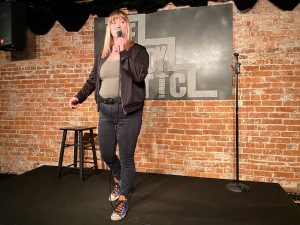
Shanda Sung at The Comedy Attic | Photo by Christine Brackenhoff
“I learned the basics of joke writing, like the building blocks of how to design a joke and how to build a set,” explains Sung. “I also learned the nuts and bolts of how to stand on stage, what you do with the microphone, and what to avoid saying to not seem like an amateur. That class ended with us doing a show at The Comedy Attic, with everybody’s friends and family, so it was a super supportive room. It just felt amazing. Once I did it that one time, I was off and running.” As a full circle experience, Sung taught the Ivy Tech class in 2022.
Some comedians start writing and performing primarily through observation. Comedian Emil Wakim, a Chicago native, always wanted to do something around comedy and was unhappy studying business at Indiana University. A friend suggested that Wakim reach out to The Comedy Attic — assuring him that he was in Bloomington for a reason — and encouraged him to make the best of it. Wakim pitched The Comedy Attic co-owner Jared Thompson on assisting with promotional materials. Thompson asked Wakim if he could make a new introduction video, which Wakim agreed to with no prior video production experience.
“So I just skipped class for a whole week and Googled and watched YouTube videos on how to use Adobe programs,” Wakim says. “Jared liked what I made, so I started getting in his good graces.” Wakim started working at the club, assisting with marketing tasks such as poster creation. “That was my foot in the door to start doing comedy,” he notes.
In its earliest days, The Comedy Attic was called The Funny Bone, which was when Alano-Martin got started as a comedian. As an audience member, the first show he saw at the club was the final round of the Bloomington Comedy Festival, an annual contest. “There were three really funny people on stage, but they were attainably funny. That kind of put the bug in me, where I was like, ‘I think I could do that. I think I could be as funny as they were.’ I never had that thought listening to a George Carlin record or watching a professional stand-up show.” After a few months of thinking about it, Alano-Martin tried open mic for the first time during a spring break weekend in 2009.
The influence of The Comedy Attic
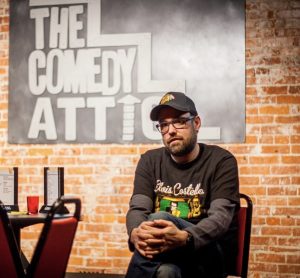
Jared Thompson, co-owner of The Comedy Attic | Courtesy photo
In 2008, The Comedy Attic’s co-owners Jared and Dayna Thompson originally considered opening a coffee shop or bookstore, with Dayna’s background in serving and love of reading. However, they noted that downtown Bloomington was already saturated with these, and ultimately landed on the idea of a comedy club. “I had booked punk shows, so I had a background in booking, but I’d only ever booked Neil Hamburger as a comedian,” Jared Thompson recalls.
When the club launched a decade and a half ago at the corner of South Walnut and East 4th streets, the Thompsons never imagined The Comedy Attic would become what it is today. “A comedy club wasn’t a good idea, and it still isn’t,” Jared Thompson states. “But it’s what we did and we made it work. What we ended up with was ten times better than what we could have ever expected it to be.” Some may also think that a brick-and-mortar bookstore is risky business in the digital age, but the Thompsons recently bought Caveat Emptor on the square in downtown Bloomington, reviving Dayna’s earlier vision.
Although touring comics visited Bloomington before The Comedy Attic opened its doors, Alano-Martin affirms that Bloomington’s own local stand-up scene is correlated with the club’s presence. “There was no local stand-up comedy scene before The Comedy Attic, in my opinion,” Alano-Martin says. “There was a place that had comedy shows for many years, and a local emcee would host every single show, but every feature and headliner were touring acts that came through. You have to have an open mic and a set structure. If you get good enough at the open mic, you get to host. Then you get the mic [as a feature or headliner]. That’s why it creates a scene. It creates opportunities for people to do things and to be peers to one another.”

Mat Alano-Martin at The Comedy Attic | Photo by Christine Brackenhoff
In addition to providing a dedicated space for stand-up comedy, The Comedy Attic has high standards for those that step up to the stage. Insulting marginalized groups has no room at The Comedy Attic. “The number one biggest problem in comedy is punching down. It’s just not up for debate,” Thompson emphasizes. The second biggest problem, he asserts, is how people of color and members of the LGBTQ+ community are treated.
Racist, homophobic, transphobic, misogynistic, and rape jokes are prohibited at The Comedy Attic. “Nobody on earth can write a good joke about these. There’s no nuance to it,” explains Thompson. He believes that expectations established early on for jokes have benefitted the local comedy scene in the long run.
Prioritizing diverse lineups is not only important for the sake of representation, but also for the overall quality of a show. When The Comedy Attic opened, agencies predominantly pitched white men to them. However, comedians and audience members have noted that the Thompsons have been extremely intentional about booking comedians from a variety of gender, racial, and sexual identities. “Jared and Dayna really value comedy as an art. They want good comedy that makes people laugh and think,” notes Davis. “They want to give spaces to people who may not get the same opportunities elsewhere, so they really go out of their way and prioritize women and people of color in booking headliners.”
Shanda Sung concurs with this value. “When you are seeing multiple people doing a different flavor of the same joke over and over again, it loses its potency. It loses its interest,” she notes. “But when you have people with totally different comedic voices and life experiences coming up, it just makes the show so much richer.”
As long as comedians avoid “punching down” and treat themselves as artists, there is an understanding that they will be supported. Harlan Kelly, a former Bloomington comedian now based in Denver, appreciates the culture instilled by The Comedy Attic. “There’s something really special about The Comedy Attic because it fosters astute comedy, allows for both students and local residents to access the space, and expects the same level of professionalism from everybody,” explains Kelly. “They encourage you to take yourself seriously, in a way, and this helped me so much as a performer. You don’t have to be good right away. You don’t need to have experience or a resume. You can do the weird thing, you just have to keep trying to do it better and better. You have to actually care about what you’re doing and believe in yourself. That has really stayed with me.”

Emil Wakim at The Comedy Attic | Photo by Tall and Small Photography
Regarding touring comedians, Thompson maintains that audiences may not see every great comedian at The Comedy Attic, but they will not see lousy ones. Emil Wakim agrees. “When I was working there, I’d watch one of the best comedians every weekend,” he recalls. “I was studying their comedy all the time. Even if they were younger and newer, there were no duds that ever came through. There’s such a high quality control there because Jared is particular about how he runs the club. You’re around such good comedy all the time that you start absorbing it.”
Not only do audiences see notable touring comedians, but local comics have the opportunity to work directly with them at The Comedy Attic. “If I was in any other similar-sized city, doing exactly what I’m doing now, I would not have the list of incredible opportunities that I’ve had,” Sung notes. “I’ve been able to work with Marc Maron and people from Saturday Night Live and Maria Bamford. All that just doesn’t happen in other communities.”
In addition to relationship-building, when local comics have more frequent and longer amounts of stage time working alongside major headliners, Emily Davis notices they learn more and develop their skills. “It’s like a school of comedy,” she explains. “There are a lot of opportunities to perform and to learn, and normally you have to choose between one or the other.”
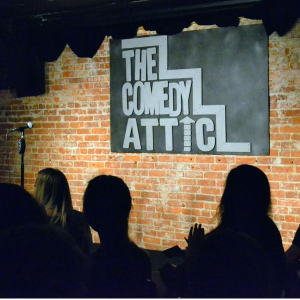
The Comedy Attic, on the corner of South Walnut and East 4th streets
Becoming a professional comedian tends to be a slow and gradual process, but Wakim believes that this early exposure to touring comedians boosted his growth. “You get to work with headliners without distraction,” he notes. “It’s a fight to get eyes on you in bigger cities. In Bloomington, it’s sort of the opposite. You’re working with someone for a weekend. You’re their opener. There’s no one else trying to meet them and make them watch a clip of themselves or whatever. You get a direct chance, and that was a big part of comedy becoming my job. I met Nikki Glaser, who was a huge help for me. When I moved to New York, I had so many connections. I got to open for people and it just made it that much easier to start moving up the ladder.”
Since moving to New York City in late 2020, Wakim has toured with Nikki Glaser and performed on NBC’s The Tonight Show.
Bloomington audiences as supporters and reviewers
With Bloomington being a college town, Shanda Sung notes that there are advantages of interacting with younger audiences at open mics. “For example, young guys like to be made fun of a little bit, so you can do crowd work and pick on them a little bit,” she notes. “My favorites are when it’s parents’ weekend or something. You see a lot of parent-child groups and you see their relationship to each other changing in real time as they’re watching each other laugh at things. For example, ‘Oh my gosh, did my dad just laugh at that sex joke?’ I love that so much. They can see each other a little bit more as peers in a comedy club.”
“
When you have people with totally different comedic voices and life experiences coming up, it just makes the show so much richer. —Shanda Sung
”
With an abundance of 20-somethings in Bloomington, it is easy for younger comedians to focus on speaking to their own demographic, but reaching all age groups is a rewarding challenge. “I really have to try to make my point of view relatable to everyone else,” notes James Tanford. “I’m a young man. I go to The Attic and I see fifty frat guys who look just like me, and think, ‘Oh, they’re gonna get this.’ But, sitting behind them is a table of 40-year-old moms. I can tell when something’s hitting with one part of the room and not the other.”
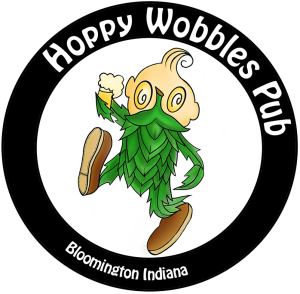
Hoppy Wobbles Pub, 3876 W. 3rd St.
These moments motivate Tanford to change up his set, because he wants to make everyone in a room laugh. He also enjoys trying new jokes out at Hoppy Wobbles Pub on the west side of Bloomington. “We call it the ‘Sloppy Seconds Open Mic.’ I can try anything there as a starting point,” he says. “One joke will get a big pop and I go, ‘Oh, maybe there’s something here.’ Then I start running it at other places and adjusting it.” Tanford notices that if a joke works at both Hoppy Wobbles Pub and The Comedy Attic, it will probably work anywhere.
While Bloomington has a reputation for being a “blue dot in a red sea,” comedy attracts audiences of various identities. “In Bloomington, you’re not just performing for liberal elites all the time. You have people that come in from smaller rural towns to see a comedy show,” notes Mat Alano-Martin. “They also know they’re coming into Bloomington, and so I think they’re accepting, like, ‘Okay, we’re gonna hear some of this.’”
Alano-Martin says that making someone laugh in spite of their own personal beliefs, regardless of where they fall on the sociopolitical spectrum, is extremely rewarding. “For example, if you’re dunking on Obama and can get a liberal to laugh at that, that’s the best. But I think Bloomington just has a pretty good head on its shoulders and a pretty good sense of humor about stuff. You can kind of go dark, you can go weird. You can go a little dirty, a little political, and it all plays pretty well in Bloomington.”

Emily Davis | Courtesy photo
While Bloomington comedy fans are welcoming, they tend to give genuine feedback. “Mike Birbiglia called me before the first Broadway show that he did,” Jared Thompson recalls. “He came here the week beforehand to get ready for it, because he knew our audience would give him the correct feedback. It’s not even just good or bad, it’s correct. It’s a blend of not only laughing, but not laughing. The majority of the time, our audiences are going to legitimately give you the answer that you’re looking for about a joke. It’s a currency that you just can’t get at most places. That’s why you see such famous comedians come and work out something before they go on a bigger tour. They know that these audiences here are going to tell them what to do.”
As a growing comedian in Bloomington, Emil Wakim learned that being cordial on-stage is just as important as having strong jokes. “In high school, in Chicago, I did one open mic. There were eight people in the room, who were other comics on their phones. I thought I had to say anything to get people to look up. I think a lot of bad comedy starts that way, just getting something out of a dead room,” Wakim recalls.
“Starting in Bloomington, you get to be taken seriously pretty early, which is a really big gift,” Wakim says. “My first time was bad, I was just hacky and trying to do shock value. Then, I stupidly and naively asked Jared for assurance that it went well. Instead, he said that my set was kind of mean. He told me that this would be so much easier, and that I would go so much further, by being funny and being nice. Starting out, that was a thing I’d always hear, and I think Mat [Alano-Martin] said that a lot. It’s a good way to describe Bloomington’s comedy scene, and a good lesson to learn.”

Harlan Kelly at The Comedy Attic | Courtesy photo
Similarly, Maria Bluck drew larger lessons from her involvement in Bloomington comedy. “The people I first met in Midnight Snack were really big on this concept of support. Any improv nerd will tell you that’s the backbone of improv, but they really lived it,” Bluck recalls. “They were huge on being a team. Like, ‘We’re not all out to get you, we’re all trying to do this thing together, it’s fun and it’s good.’ We were all psyched about making art. That really shaped the way I talked to other performers and the way I talked to my friends. It changed my perspective.”
During the summers, The Comedy Attic hosts the Bloomington Comedy Festival, a multi-week competition in which audiences vote for the top performers of a particular show. Dozens of local comedians enter the festival, and over the course of the summer, winners are picked to proceed to the next level. Then, a champion is elected in the final round.
“It’s really inspiring,” Sung notes. “For one, I have a deep love of competition. You can’t repeat material in the first few rounds, so it pushes you. If you do five minutes one round, then make it to the next round, you need a new five minutes of material. I come out of the contest with at least fifteen new minutes to play with every year.” Sung believes that being pushed to write new material quickly is very helpful for new comedians.
A decade of the Limestone Comedy Festival
A couple years into his comedy career, Mat Alano-Martin entered comedy festivals that largely fell into two categories: well-meaning but poorly run, or large impersonal festivals that treated unfamous comics as an afterthought. Driving home from one of the latter, Alano-Martin started developing the idea of Limestone Comedy Festival in his head. He asked himself, “How could we design a festival where the comics get treated really well, and it’s not a cash grab for the audience?”
Initially, Limestone co-founder Jared Thompson was hesitant about the idea of a festival. “What really turned me was that Mat explained how the comedy festivals he had been in were run, and how easy it would be for us to do one where we fix all the wrongs he had found in other festivals.” An example of one of these wrongs: limited opportunity to see a particular comedian. “If you don’t schedule multiple performances by a comedian, and if two shows happen at the same time, attendees might have to pick one. And that’s terrible. Nobody wants to have to do that,” notes Thompson. “We knew that we wanted to be badge-based, and we wanted everybody to be able to see a particular comedian if they really, really, really want to.”
“
Bloomington just has a pretty good head on its shoulders and a pretty good sense of humor about stuff. You can kind of go dark, you can go weird. You can go a little dirty, a little political, and it all plays pretty well in Bloomington. —Mat Alano-Martin
”
When creating the festival schedule, Limestone not only minds audience opportunities, but they also want to ensure that all comics are treated respectfully. “One of the problems I had, particularly with the bigger festivals, was that they would have the shows completely separate,” Alano-Martin notes. “I went to one that had Anthony Jeselnik in one venue, and across the street was Whoopi Goldberg at the other one. And then my show was me and nine other equally famous people in the basement of a frat bar, which was also having crunk night on the main floor. Why would anybody come see our show if you could go see Jeselnik or Goldberg?”
Therefore, since the festival launched in 2013, Limestone made it a priority to appreciate every comic that submitted and traveled to the festival to perform. Limestone provides opportunities for emerging comedians to open for more famous ones. They also avoid treating performers differently behind-the-scenes. “There are no separate green rooms. There is no ‘famous artists’ lounge,” Alano-Martin points out. “We treat all of them as well as we possibly can.”
In addition to valuing all participating comedians, Limestone offered an oasis in a comedy festival desert. “The first couple of years, a lot of people would drive in from Michigan, Ohio, and Tennessee to come to our festival,” Alano-Martin recalls. “At that time, it was the closest big comedy festival if you were a super comedy nerd and wanted to spend a couple of days. Now, comedy festivals are a little bit more common everywhere.” He also notes that launching the festival on a larger scale with prominent comedians, rather than starting smaller with goals to grow, proved beneficial.
“That was Jared’s vision, to come out big,” Alano-Martin says. “If we would have been a smaller festival, then people probably wouldn’t have driven here. But our first year, we had Maria Bamford, Tig Notaro, Pete Holmes, and Doug Benson in the theater. That’s even before you got into a small venue. Then year two, we had Patton Oswalt, which was pretty much unheard of outside of major huge festivals.” Aiming high early on helped cement Limestone’s reputation as a top comedy festival in the country, and a rarity outside of major cities.
“
That’s why you see such famous comedians come and work out something in Bloomington before they go on a bigger tour. They know that these audiences here are going to tell them what to do. —Jared Thompson
”
At Limestone Comedy Festival, the Blooming10 showcase highlights ten local comedians with performances at the Buskirk-Chumley Theater. Volunteering has also been an element of Limestone, which Harlan Kelly did during their time in Bloomington. “The position I was given was specifically to handle chaos,” they recall. “And it was very fun because of that. I got to do all these small things to help make it happen. Especially as a younger person trying to figure out how the arts business and art events work, it was inspiring to see the inner workings and to see these folks, who dreamed this whole thing up and have a system for it.”
In 2020, Indianapolis-based comedian Dwight Simmons joined Jared Thompson and Mat Alano-Martin as a Limestone Comedy Festival co-director. “Dwight has really given the festival a second life,” Alano-Martin notes. “It had fallen into a little bit of a routine, I think, and Dwight brought a sort of excitement back to it. We don’t know how we did it without Dwight before. I mean, Jared and I were pretty adamant that the tenth year would be the final year, but we have Dwight now, and that’s no longer the conversation. I think we’re going to be going on and on and on for now.”
Now in its tenth year as part of the Bloomington comedy constellation, Limestone Comedy Festival is scheduled to take place June 1–3. For fans, emerging artists, and seasoned professionals alike, the town continues to be a trusted curator and home base for live comedy.
LOL Locally
Mat Alano-Martin: mat-alano-martin-comedy.com/
Maria Bluck: instagram.com/maria.bluck/
Emily Davis: instagram.com/lilemdavis/
Shanda Sung: instagram.com/shanda.sung/
James Tanford: instagram.com/jamestanford/
Emil Wakim: emilwakim.com/
The Comedy Attic: comedyattic.com/, corner of South Walnut and East 4th streets
Limestone Comedy Festival: limestonefest.com/
Hoppy Wobbles Pub: hoppywobbles.com/, 3876 W. 3rd St., (812) 287-7770
Indiana University Troupes
Ladies’ Night Comedy: https://www.instagram.com/ladiesnightcomedyiu/
Midnight Snack Comedy: https://www.instagram.com/mnscomedy/
University tWits: https://www.instagram.com/twits_iu/



